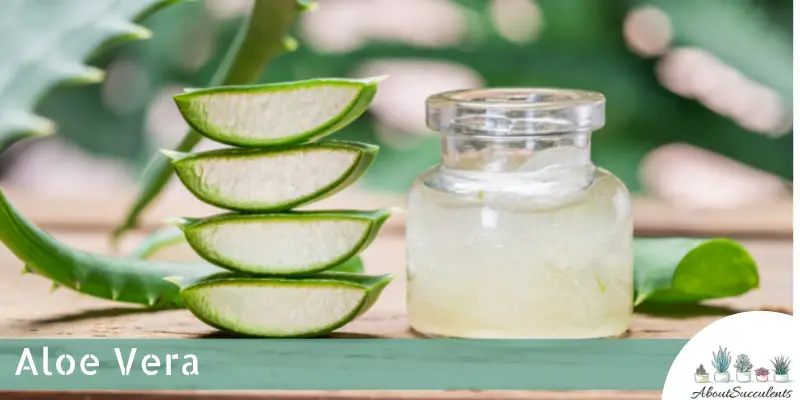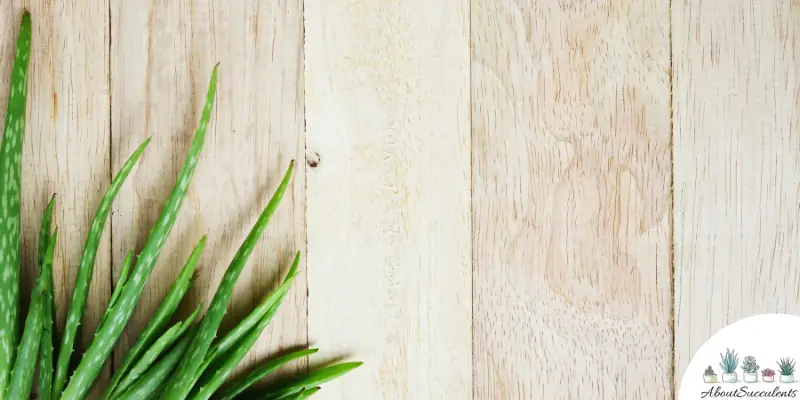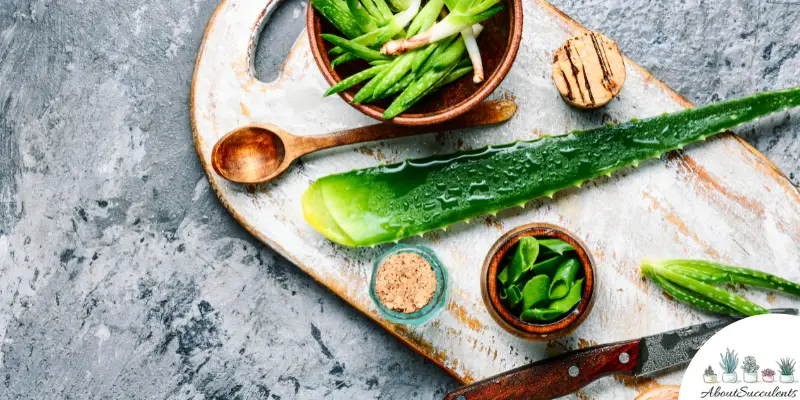
Aloe vera is a popular succulent that almost needs no introduction because you can find it in many homes, gardens, and as an ingredient in various consumer products.
The main reason for its popularity is that this variety of succulent plant has been studied to have numerous medicinal properties. Aloe Vera’s healing and medicinal properties have been recorded since the time of Christ.
Among the studied health benefits of using Aloe Vera include anti-aging, anti-inflammatory, and the ability to heal wounds.
A fully mature Aloe Vera succulent can reach a height of 61cm (24”) and a width of 61cm (24”).
Aloe Vera is native to Africa, Madagascar, India, and the Middle East. It goes by different names such as Flower of the Desert, Mediterranean Aloe, Urguentine cactus, Lily of the Desert, Elephant’s Gall, and Barbados Aloe. The most commonly used alias is Medicinal Aloe. It is part of the Asphodelaceae family.
General Information:
Also known as: Medicinal Aloe, Flower of the Desert, Mediterranean Aloe, Urguentine cactus, Lily of the Desert, Elephant’s Gall, and Barbados Aloe.
Plant Family: Asphodelaceae
Origin: Africa, Madagascar, India, and the Middle East.
Height: 61cm (24”)
Exposure: Partial or direct morning sun for up to 6 hours
Water Needs: Drought-tolerant; give water only when the soil has completely dried out.
Soil Type: Cactus mix with gravel, sand or pumice.
Soil pH: 7.0 to 8.5
How to Grow and Care for Aloe Vera

Aloe Vera is grown as a houseplant and can be found in many bathrooms and kitchens. In warmer and more tropical climates, Medicinal Aloe is grown outdoors in a garden or as a container plant.
Aloe Vera is one of the easiest succulent plant varieties to grow and care for because it is drought tolerant.
Medicinal Aloe requires less watering than other succulent plants. It is not a cold-hardy succulent and thrives in regions where temperatures are at a minimum of -6.7° C (20° F).
Sunlight
Aloe Vera grows well under partial or direct sunlight. As a garden or an outdoor container plant, make sure Medicinal Aloe gets at least 6 hours of morning sunlight every day.
In regions where temperatures fall below -6.7° C (20° F), we recommend growing Aloe Vera as an indoor plant.
Place the potted plant near a window that gets 3 to 6 hours of morning sunlight every day. You can also put Medicinal Aloe under a Grow Light.
Watering
Overwatering Aloe will lead to its demise. Only give it water when the soil has completely dried out. The soak and dry method is the best way to water Aloe Vera.
To test the moisture level of the soil, insert a stick an inch into the topsoil. Pull out the stick and check if its end is dry. If you are satisfied with the test result, give the soil a thorough soaking.
During the colder months, the soil will hold moisture longer so the watering schedule must be less frequent compared to months when the climate will be warmer.
Pot and Soil
If you want to grow Medicinal Aloe in a pot, choose one that’s made of ceramic or terracotta. These types of pots are the most ideal to grow succulent plants in because they allow for the proper evaporation of moisture from the soil.
The size of the pot must be big enough to allow the roots to grow properly. If the pot is too small, the roots will end up tangled and the soil will not have proper air circulation.
Cactus mix is the ideal soil variety for Aloe Vera because it is well-draining. To improve drainage, add ingredients such as gravel, sand, and pumice. Fertilize the soil once a month during the Spring to give the succulent a growth boost.
Drainage is important because you cannot leave the roots of a succulent plant immersed in moist conditions for a long time. Otherwise, the roots will rot.
How to Propagate Aloe Vera

Horticulturists love Debbie because the succulent plant offers 4 ways to propagate the species: Stem and leaf cuttings, offsets, and seeds.
There is only one way to propagate Aloe Vera and that is with its offsets. Unlike other succulent plant varieties, you cannot successfully propagate Medicinal Aloe with its leaf cuttings because the leaves can rot right away.
Step 1: Aloe Vera will reward you with many pups or offsets that sprout from the base of the plant.
Step 2: Gently pull out the offsets from the soil.
Step 3: Place the offsets in a dry and warm area and allow them to develop hard calluses over 2 to 3 days.
Step 4: Place the dried-out offsets on a pot filled with a cactus soil mix.
Step 5: Water the soil only when it has completely dried out.
Frequently Asked Questions
Is Aloe Vera Toxic to Cats and Dogs?
Yes. Aloe Vera appears on the list of plants that are toxic to cats and dogs in the website of the American Society for the Prevention of Cruelty to Animals (ASPCA) list of plants that are toxic to cats and dogs.
Why Is My Aloe Vera Dying?
If your Aloe Vera shows discoloration and other signs of weakness, it could be because of 2 reasons: Overwatering and pest infestation.
Overwatering
When the roots remain in a moistened soil for a long time, they will rot. The rotting will lead to fungal growth that will infect the entire plant. You might notice that the leaves or the stems of Medicinal Aloe turning brown or blackish.
If you see discoloration, you must act right away. Cut off these infected parts by using a sharpened and sterilized pair of garden scissors or a knife.
Then, remove the plant from the soil. Shake off the excess soil and examine the roots for signs of advanced rotting. Cut off the rotted roots with the garden scissors.
Place the plant in a warm area and let it dry out. Prepare a new home for Medicinal Aloe by filling a pot with cactus soil. Replant Aloe Vera and water the soil only when it has dried out completely.
Pest Infestation
Mealybugs, aphids, and mites can infest Aloe Vera and drain the plant of nutritious sap. The presence of these pests can lead to fungal infection.
Spray Medicinal Aloe with neem oil or wipe the leaves with 70% isopropyl alcohol to get rid of these disease-causing insects.
Does Aloe Vera Produce Flowers?
Yes, Aloe Vera produces a tall, slender stalk of beautiful yellow flowers in the summertime.
Last Updated on June 9, 2022 by Sofia Lara